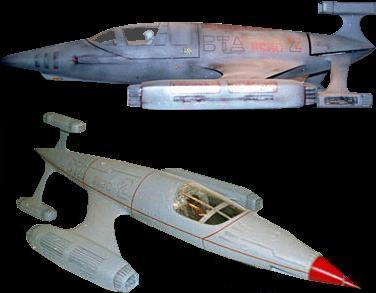


S/A-Ø6 Flyjt Attacker



S/A-Ø6 Flyjt Attacker
 An S/A-Ø6 Flyjt Attacker. |
| * Fuselage- ** Cockpit- *** Variable Rear Thruster- *** Wings (2)- *** Tailerons (3)- | 2ØØ 15Ø 15Ø 1ØØ each 1ØØ each | *** Grav Pod (1)- MRM Launcher Pods (2; wing mounted)- Landing Struts (3)- Laser Cannons- | 1Ø 5Ø each 1Ø each 5Ø each |
Speed and Statistical Data: Weapons Systems: 2. Ventral SRM Launcher: Adopted from the Spacer II Space Fighter. 3. MRM Launchers: Mounted on the wings. 4. Partial-Barrier Force Field: The Flyjt Attacker is HIGHLY vulnerable to attacks from behind. With this in mind, it has been equipped with a shield system to cover this area. The field actually generates a “bubble” of 1Ø feet. Features:Taxiing on the ground: 1Ø MPH
Range On Land: About 1 mile normally; 1Ø miles max.
Flying: Mach 2Ø
Combat Radius: 1ØØ,ØØØ miles. Can be refueled in the air.
Height: 1Ø feet
Wingspan: 2Ø feet
Length: 1ØØ feetWeight: 2Ø tones
Cargo: Pilot’s emergency gear only. All pilots must wear flight armor when flying.
Power System: Single Gimble-Mounted RET-47 Hydro-Cell Rocket Engines.
Flight Systems: Grav Pods
Cost: 1Ø million credits each
Availability: 1 months to build.
Black Market Cost and Availability : Between 1,ØØØ and 25Ø million credits, depending on buyer and seller; Occasionally available.1. Nose-Mounted Laser Auto-Cannon:The original laser was a native design; During the period between the invasion, an Ator design was used. However, after linking up with the REF an new laser design was installed, based on a slightly cut down version of the MAC II’s laser arms. Only one is installed, whereas the original design had 2 lasers. Never the less, this is a significant improvement in firepower.
Purpose: Anti-Bomber/Ship.
MD: 2D6×1Ø per blast.
Range: 8 miles.
Rate of Fire: Per pilot’s attacks per melee.
Payload: Unlimited.
Purpose: Anti-Missile Defense
Missile Type: Short Range.
MD and Range: Varies by type used
Rate of Fire: Volleys of 2, 4, 5, or 1Ø times pilots attacks per melee.
Payload: 4Ø
Cost: 3,ØØØ credits each.
Availability: Routinely available
Purpose: Anti-ship
MD and Range: Varies by type used.
Rate of Fire: Volleys of one per pilot’s attacks per melee.
Payload: 1Ø missiles.
Purpose: Defense.
MDC: 25Ø; Regenerates 1Ø MDC per hour WHEN NOT BEING ATTACKED.
Range: 1Ø feet; Will also deflect or stop all bursts while active.
NOTE: The shield is able to regenerate 1 MDC per every 6 minutes the Flyjt is not in combat; However, once the shields have been destroyed, the field generator must be replaced.5. Wing Mounted Weapons Systems: The Flyjt can carry up to 4 pods. 7 Rocket Launcher: 24 2-inch rocket tubes in 12 rows of 4 each. Each rocket tube has 4 rockets.
Purpose: Heavy Assault
MD: Each rocket does 2D6 MD
Rate of Fire: Volleys of 6 or 12 times pilots attacks per melee.
Range: 12,ØØØ feet
Payload: 96 per pod. Up to 6 pods can be carried.
Primary Purpose: Anti-Aircraft
Secondary Purpose: Anti-LRM.
Damage: Varies by type used.
Rate Of Fire: Volleys of 1, 2, 3, or 4 per pilots attacks per melee.
Effective Range: Varies by type used.
Payload: 32 (4 per launcher, 6 pods per wing).7Ø
Effect: While active, enemy radar will have a “wash” effect, where a large, highly unstable cloud of radar paint will appear. An experienced (5th level and above) radar operator can SOMETIMES use the flow of the wash to narrow down the source of the jamming, but typically this does little good. NOTE: This IS a form of radar signal, and can therefore by tracked by some ESM systems (-1Ø%).7 pod, used to drop highly sensitive and extensive messages. A nose-mounted device using GPS or laser detection guides the pod to within ⅛th of an inch of the intended target.
Optic Systems: Infrared: 2Ø miles; Magnification: 15×; Ultra Violet: 22 miles; Magnification: 25×; Night Vision: 24 miles; Magnification: 8×; Color Filters: 19 miles; Magnification: 2ØØ×; Thermal Imager: 1Ø miles; Magnification: 4Ø× Effect: Duration: 1D4 melee rounds. Payload: 6Ø chaff/flares. Each time the system is engaged, the system fires off Ø4 chaff/flares. |


